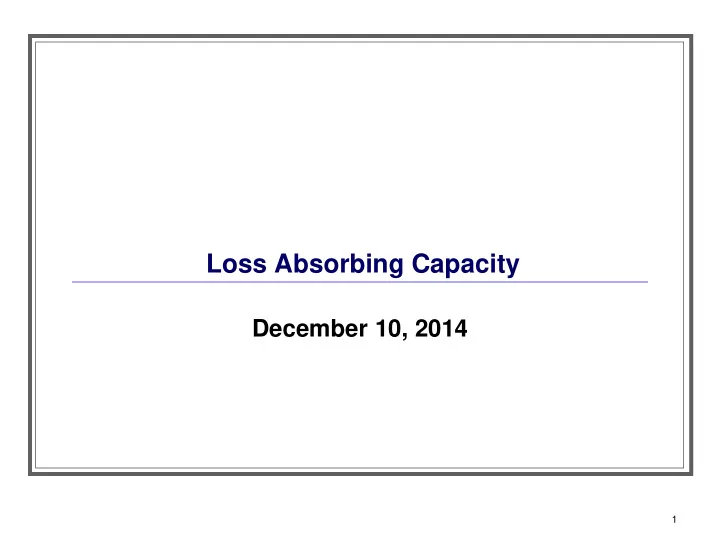

Loss Absorbing Capacity December 10, 2014 1
Background Firms need a sufficient amount of unsecured liabilities to absorb losses and to immediately stabilize the critical functions of the firm following a failure This is in addition to requirements to hold sufficient equity capital to potentially avoid a resolution through recovery measures In the U.S., since late 2012 - early 2013, the FRB has discussed a potential requirement for firms to issue minimum amounts of unsecured long-term debt Internationally, the FSB recently developed a proposal on total loss absorbing capacity, or TLAC 2
TLAC − Status Consultation on loss absorbing capacity for global systemically important banks released by FSB in November 2014 The comment period runs through February 2, 2015 Quantitative Impact Study and market survey to be carried out by early 2015 Standard to be implemented at the national level 3
Key Terms − External TLAC Minimum external TLAC requirement of 16-20% RWAs; twice Basel 3 Tier 1 leverage ratio requirement Jurisdictions may impose more stringent requirements Requirement applicable to each ‘resolution entity’ within the group Debt component: At least 33% of the minimum requirement should be met with T1/T2 debt or non- regulatory capital instruments Subordination requirement 4
Key Terms − Internal TLAC Loss absorbing capacity is required to be prepositioned with ‘material subsidiaries’ Each material subsidiary must maintain internal TLAC of 75-90% Jurisdictions may impose more stringent requirements Internal TLAC should be pre-positioned on-balance sheet, unless otherwise agreed Secured guarantees may be utilized if agreed between home and host 5
Comments to SPOE Notice December 10, 2014 6
SPOE Notice 29 written comments received Issues: Global cooperation Liquidity and capital Valuation/Claims Exit from bridge financial holding company Subsidiarization 7
Global Cooperation Comments focused on: Cooperation during a crisis Desire for binding agreements by the FDIC Local-level loss absorbing capacity Possibility of amending Chapter 15 of the Bankruptcy Code to add the recognition of foreign resolution regimes 8
Capital and Liquidity Comments focused on: Private-sector financing in a crisis Recapitalization and the amount of intercompany debt needed at each subsidiary Insolvent subsidiaries (especially if financial distress infects the entire group) Repayment of counterparties Perception of OLF as a bail-out mechanism 9
Valuations/Claims Comments focused on: Need for specific information about claims and valuation processes Difficulty of valuing assets and determination of which claims are fully secured Ability of creditors to price risk Disparate treatment Creditors’ committee Franchise value 10
Exit from Bridge Financial Holding Company Comments focused on: Maximizing value Creating multiple firms that are less complex 11
Subsidiarization Comments focused on: Promotion of simpler and more transparent corporate structures Equivalence to pre-ring fencing Separation of subsidiaries for support services 12
Wind-Down in an SPOE Resolution December 10, 2014 13
Imperative for Wind-Down in Resolution Title II requires a report to Congress within 60 days: “describing the plan of, and actions taken by, the Corporation to wind down the covered financial company” The FDIC has established winding-down as an integral part of the single point of entry resolution process In addition to changes that occur during the bridge period, a plan for winding down would be required by the FDIC for any entities that emerge from the bridge This plan would ensure that any emerging entities: Would not pose systemic risk Are resolvable under the Bankruptcy Code 14
Driving Factors of Wind-Down Process: Current efforts to simplify operations and provide for optionality in resolution will facilitate winding down under bankruptcy or Title II In Title II, an initial operating agreement would require bridge management to formulate a plan for winding down This would necessarily include identifying and addressing the causes of failure to ensure viability Other steps to make the firm smaller and less complex might entail: More closely aligning operations and legal entity structure Dividing the company into several companies or selling parts of entities Some parts of the business would likely be liquidated as a result of the failure 15
Type of Activities Would Impact Approach: Representative G-SIFI Organizational Chart (Simplified) Parent Hold Co. U.S. Retail U.S. Asset India Service U.S. Bank (IDI) Broker-Dealer Management Co. London Branch Japan U.S. Commercial U.K. Commercial Commercial Broker-Dealer Broker-Dealer Broker-Dealer Cayman Branch 16
Timeframe and Post Bridge Requirements: It will likely be necessary that some divestitures, liquidations, or other wind down actions initiated during the 6 to 9 month bridge period will be completed after the termination of the bridge Wind-down plans would require FDIC approval and be enforceable subsequent to the termination of the bridge Ongoing requirements for winding down would need to be disclosed and factored into any valuation Living will requirements would further ensure ongoing resolvability under the Bankruptcy Code 17
Recommend
More recommend